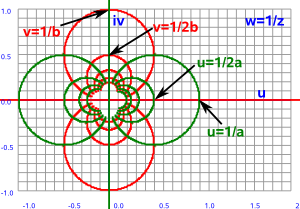Conformal Transformations
Transformations where the angle between two intersecting curves in Z plane equals the angle between corresponding curves in W plane.
A transformation is conformal where dw/dz ≠ 0 and the function is regular.
Differentiation
Is defined if dw/ dz is independent of angle.
In this case: dw/dz = dw/idy
therefore dv/dy - j du/dy = du/dx + j dv/dx
This gives the Cauchy Riemann equations:
dv/dy = du/dx
dv/dx = - du/dy
Harmonic Functions
∂u/∂x = ∂v/∂y —> ∂²u/∂x² = ∂v²/∂y∂x
∂u/∂y = -∂v/∂x —> ∂²u/∂y² = -∂v²/∂y∂x
therefore
∂²u/∂x² = -∂²u/∂y²
∂²u/∂x² + ∂²u/∂y² = 0
Therefore if a function obeys the Cauchy riemann equations then the real part is a harmonic function.
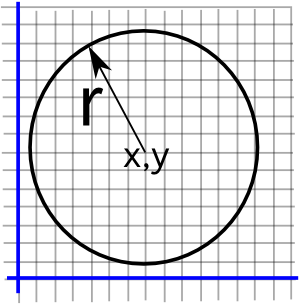 |
(x - x1)² + (y - y1)² = r² | |z-d| = r |
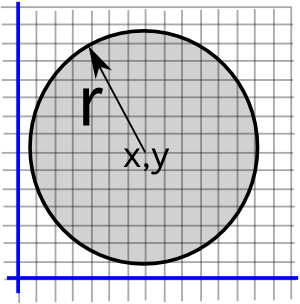 |
(x - x1)² + (y - y1)² < r² | |z-d| < r |
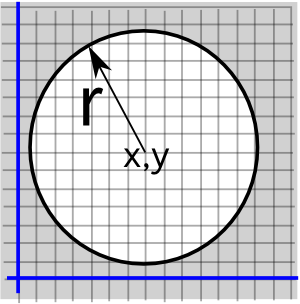 |
(x - x1)² + (y - y1)² > r² | |z-d| > r |
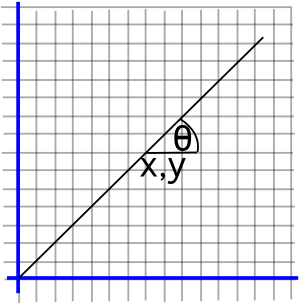 |
tan-1(y/x) = θ | arg(z)=θ |
| z plane | w plane | |
|---|---|---|
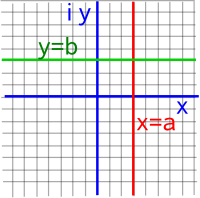 |
--> w=z² |
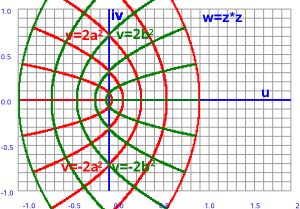 |
 |
--> w=ez |
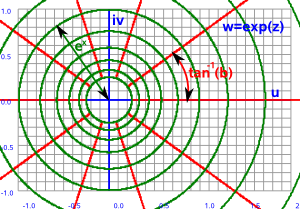 |
 |
--> w=1/z |
|
Specific information about these functions is shown in the complex number part of the site (functions of a complex variable).
Cauchy's Theorem
If f(z) is analytic in a region R (no poles in R) then:
![]() f(z) dz = 0
f(z) dz = 0
Extension of Cauchys Theorem
∫ round same singularities are equal.
∫ round several singularities = sum of ∫ round each singularity.
Use of Cauchys Theorem to evaluate Unknown Integral
![]() e-x² = √π
e-x² = √π
![]() e-x² cos(2 b x) dx = √π eb²
e-x² cos(2 b x) dx = √π eb²
![]() e-x² sin(2 b x) dx = 0
e-x² sin(2 b x) dx = 0
proof that:
![]() e-z² dz - > 0 as a - > ∞
e-z² dz - > 0 as a - > ∞
principles used:
- |
 f(z) dz | <=
f(z) dz | <=  | f(z) dz |
| f(z) dz |  |f(z) dz | =
|f(z) dz | =  | f(z)| |dz | <= ml
| f(z)| |dz | <= ml
Poles of a function
A function can have several laurent series each corresponding to a pole:
Laurent Series:
f(z) = an/(z-a)n + an-1/(z-a)n-1 + … +a1/(z - a) + b0 + b1(z-a) + …
where:
- a = a pole of function
- a1 = residue of pole
Evaluation of residue at simple pole
- multiply by (z-pole)
- take limit as z -> a
i.e. a1 = limz->a(z - a) f(z)
Evaluation of residue at pole of order n
a1 = 1/(n-1)! limz->a dn-1/ d zn-1{(z - a)n f(z)}
Application of poles: complex integration
![]() f(z) d z = 2 π i (sum of enclosed resides)
f(z) d z = 2 π i (sum of enclosed resides)
Evaluation of integrals between ±∞
- Find Poles
- Take suitable path
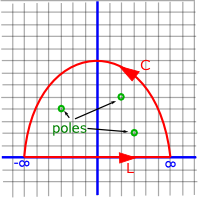
- Find residues of poles inside path
- Check if
 =0 (denominator of f(z) 2 more than numerator) (proof uses
=0 (denominator of f(z) 2 more than numerator) (proof uses ≤ml)
≤ml)
